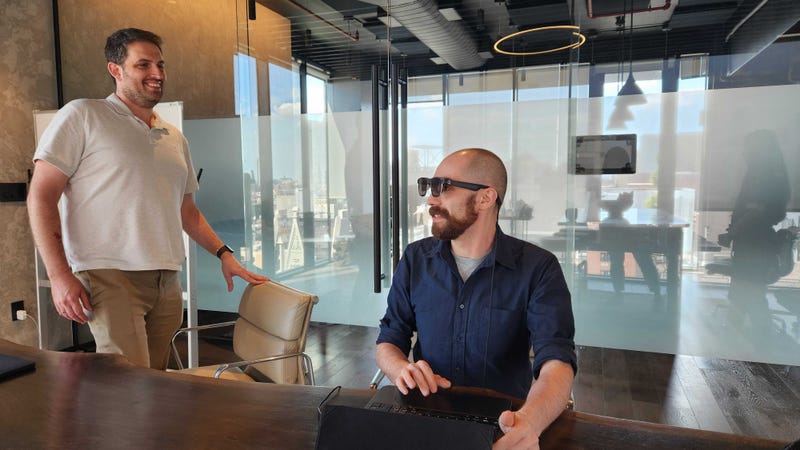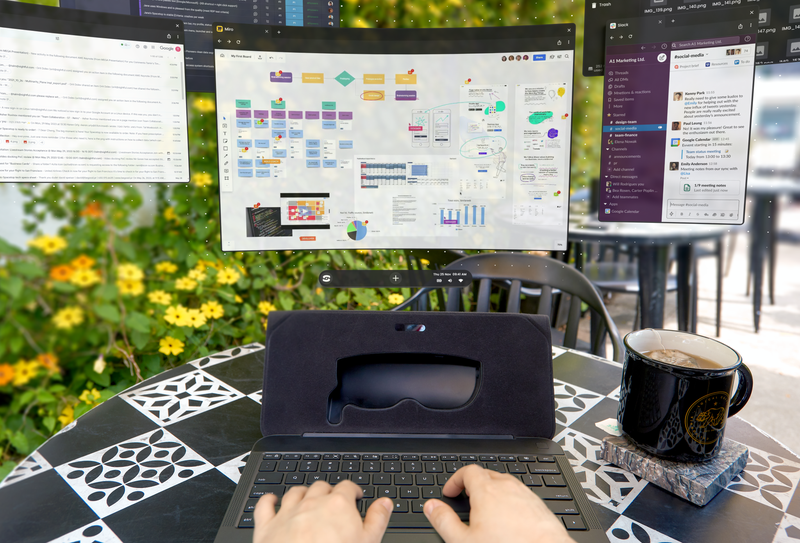The problem with the term “spatial computer” is that most devices using the obtuse marketing term don’t actually look like computers. Yes, the Apple Vision Pro or Meta Quest 3 meet the definition of “computer,” but most people still think of “PC” as a desktop or a laptop. So now there’s the Spacetop G1, an AR laptop, trying to kick both the desktop and VR markets for being too stuck in their ways.
The $US1,900 Spacetop G1 is a pair of AR glasses paired with a laptop body and a magnetic cover with a large bulge to contain it all. That would be the reductive description, but in many ways, it’s accurate. The G1 is made by Sightful, which released a beta “Spacetop EA” version last year before coming back with a modified, more ergonomic first product ready for prime time. The company boasts a few ex-Magic Leap developers who have been iterating over the past few years to create this Frankenstein contraption. The glasses are made by the folks at XReal, specifically the Xreal Air 2 Pro, though they have a few modifications meant to handle a desktop-like interface specifically.
I was invited to test out an early version of the G1 for about an hour while talking with Sightful’s execs about what the hell this thing was and where they think their tech fits into the still-nascent AR market. When wearing the glasses, you’ll see a pretty spartan UI with a blackened background that hovers a few feet in front of you and surrounds you ear to ear. You can load up various windows and lay them wherever you want on that wide desktop akin to Apple’s spatial computer. You can resize these however you wish and bring windows forward or back with a few simple gestures on the touchpad.
However, you can’t take windows and leave them around, and you can’t separate the glasses and laptop. You can take both around, and the screen will follow you and reorient itself pretty accurately. Still, if you want to interact with the folks around you, you need to take off the glasses or else look down the bridge of your nose at them, like some preppy kid on the beach offering a vain glance under his sunglasses.
Who is the Spacetop G1 For?

This is a device made for ultra-multitaskers who demand more, more, and more screens. Yes, I’m one of those who prefers a multi-screen life. Does that mean I need 100 inches and nearly 180 degrees of display real estate to get my work done? Well, I thought I didn’t, but then I’m surrounded by screens with only the barest pinch of weight on my nose, and despite myself, I could see myself turning up and tuning out with the AR-laptop lifestyle. AKA, I’d become the worst weirdo you see sitting in the corner of your local Starbucks.
Sightful CEO Tamir Berliner told Gizmodo there’s a lot of ground to cover since the laptop hasn’t honestly changed after decades of design. Mobile computers have traveled such well-trodden roads for so long that nobody is thinking about innovation anymore. Still, that tried and true design has been so entrenched that folks have a pretty good idea of exactly what they need from their laptop, and rightfully so. A bad keyboard or trackpad or slightly worse benchmarks could spell doom for any device when there’s always another device on the market able to meet those expectations.
As far as specs go, the Spacetop is using a Qualcomm Snapdragon QCS8550 from last year, which sports the Adreno 740 GPU. It has 16 GB of RAM but a mere base of 128 GB of storage with more expensive options up to 102 GB. I’d want to do direct benchmarks to compare it to other PCs, though for what it’s worth, I didn’t find the device lagged or stuttered at all despite using multiple windows on the screen at once.
The glasses include a pair of OLED displays boasting a 90 Hz refresh rate with a 50-degree field of view. The external sensors and optics have been slightly modified for the Spacetop G1, but overall, they’re a nice, light pair of AR glasses. I had no problem reading text on a page and didn’t notice any focusing or blurring as I have with small AR screens like Lenovo’s Legion Glasses. They also don’t offer the kind of field of view you’re used to with a full VR headset, meaning you’ll need to crane your neck more to look at everything on your virtual desktop.
I’d argue the keyboard is the more important part of the design. If the basic typing experience can’t match expectations, I’d argue the device could be DOA. The look of the keys first resembles Apple’s Magic Keyboard, though without any of the brand-specific keys you’re used to. It’s perhaps not the best typing experience I’ve had, with the keys feeling a little hollow with minimal travel, but it wasn’t bad either. The trackpad is a standout. It’s a nice smooth glass large enough to facilitate the multiple gestures you’d need to control the UI.
What Kind of Software Is the Spacetop G1 Using?

So, all of that works, but I’m most concerned about the software. Things were slightly buggy during my demo, which is to be expected when the final release date is still months away. Sightful’s developers told me the OS is based on a heavily modified version of AOSP (Android Open Source Project) that allows for multiple windows as well as depth tracking on the mouse. There’s a single bar toward the bottom of your view where you can open apps. As of right now, there are very few apps that work natively on the Spacetop. For applications like Instagram or YouTube, use the browser version.
Berliner said he eventually wants to release some more AR-specific applications, though those are still in development, and there’s no word when we can see what Sightful has in store for its first real AR laptop. There’s so much to consider here, but one point I will put in Spacetop’s favor is, despite that massive hill on the top of the laptop’s sleeve, it fits cleanly into my backpack’s laptop holder. The cover snaps down with a satisfying clack, and you don’t have to wind the cable in any specific way to get it all contained nice and snug.
Those who want to get in line for one need to put down $US100 on the company’s website deposit to be first in line for when Spacetop finally releases in October later this year. The device costs $US1,900, a steep price for any mobile computer. Still, if you wear glasses, you’ll have the chance to order a specific set of prescription lenses that attach magnetically to Spacetop’s AR glasses.
It’s best not to think of the Spacetop as an “augmented reality laptop,” at least for right now. You won’t flick windows around the room with hand tracking like the $US3,500 Apple Vision Pro. There really aren’t any AR capabilities save for the floating screen that is specifically tied to the laptop itself. But the screen is bright, and the darkened glasses made working even in direct sunlight possible. That’s all to say: this is an interesting, expensive new product that is, at the very least, trying something new.
Image: Sightful
